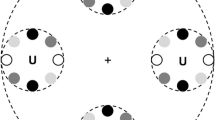Abstract
Reaction time (RT) and number of correct responses to letter stimuli were measured in 49 male and 47 female subjects under conditions of crossed and uncrossed lateralization of a pair of stimuli and the hand that performed motor reaction. Gender differences were detected on the basis of RT in the hemispheric organization when a task was performed. Males reacted more rapidly to the stimuli presented in the right visual field, while females demonstrated no lateral effects. There was a significant difference in the case of the males' right hand between crossed and uncrossed lateralization of visual stimuli, which exceeded that in the females and in the case of the males' left hand. There were no gender differences in the number of correct responses. When motor response was performed by either hand, the number of correct responses was significantly higher when the stimuli were presented in the right visual field.
Similar content being viewed by others
REFERENCES
Marzi, C.A., Bisiacchi, P., and Nicoletti, R., Is Inter-hemispheric Transfer of Visumotor Information Asym-metric?, Neuropsychologia, 1991, vol. 29, no. 12, p. 1163.
Braun, C.M., Estimation of Interhemispheric Dynamics from Simple Unimanual Reaction Time to Extrafoveal Stimuli, Neuropsychol. Rev., 1992, vol. 3, no. 4, p. 321.
Brown, W.S. and Jeeves, M.A., Bilateral Visual Field Processing and Evoked Potential Interhemispheric Transmission Time, Neuropsychologia, 1993, vol. 31, no. 12, p. 1267.
Brown, W.S., Larson, E.B., and Jeeves, M.A., Directional Asymmetries in Interhemispheric Transmission Time: Evidence from Visual Evoked Potentials, Neurop-sychologia, 1994, vol. 32, no. 4, p. 439.
Bisiacchi, P., Marzi, C.A., Nicoletti, R., et al., Left- Right Asymmetry of Callosal Transfer in Normal Human Subjects, Behav. Brain Res., 1994, vol. 20, no. 64, p. 173.
Braun, C.M.J., Sapin-Leduc, A., Picard, C., et al., Zaidel's Model of Interhemispheric Dynamics: Empiri-cal Tests, a Critical Appraisal, and a Proposed Revision, Brain Cogn., 1994, vol. 24, no. 1, p. 57.
Clarke, S., Kraftsik, R., Van der Loos, H., and Innocentti, G.M., Forms and Measures of Adult and Developing Human Corpus Callosum: Is There Sex Dimorphism?, J. Comp. Neurol., 1989, vol. 280, no. 2, p. 213.
Steinmetz, H., Janckle, L., Kleinschmidt, A., et al., Sex but No Hand Difference in the Isthmus of the Corpus Callosum, Neurology, 1992, vol. 42, no. 4, p. 749.
Steinmetz, H., Staiger, J.F., Schlaug, G., et al., Corpus Callosum and Brain Volume in Women and Men, Neu-roreport: Int. J. Rapid Communic. Res. Neurosci., 1995, vol. 6, no. 7, p. 1002.
Clarke, J.M. and Zaidel, E., Anatomical-Behavioral Relationships: Corpus Callosum Morphometry and Hemispheric Specialization, Behav. Brain Res., 1994, vol. 64, no. 1/2, p. 185.
Azari, N.P., Pettigrew, K.D., Pietrini, P., et al., Sex Differences in Patterns of Hemispheric Cerebral Metabo-lism: A Multiple Regression / Discriminant Analysis of Positron Emission Tomographic Data, Int. J. Neurosci., 1995, vol. 81, no. 1/2, p. 1.
Volf, N.V. and Razoumnikova, O.M., Gender Differences in EEG Coherence during Verbal Memory Task in Normal Adults, Int. J. Psychophysiol., 1999, vol. 34, no. 2, p. 113.
Annett, M.A., A Classification of Hand Preference by Association Analysis, Br. J. Psychol., 1970, vol. 61, no. 2, p. 303.
Eviatar, Z. and Zaidel, E., Latter Matching within and betweeen the Disconnected Hemispheres, Brain Cogn., 1994, vol. 25, no. 1, p. 128.
Lines, C.P., Rugg, M.D., and Milner, A.D., The Effect of Stimulus Intensity on Visual Evoked Potential Estimates of Interhemispheric Transmission, E. Brain Res., 1984, vol. 57, no. 1, p. 89.
Saron, S.D. and Davidson, R.J., Visual Evoked Potential Measures of Interhemispheric Transfer Time in Humans, Behav. Neurosci., 1989, vol. 103, no. 5, p. 1115.
Author information
Authors and Affiliations
Rights and permissions
About this article
Cite this article
Vol'f, N.V., Razumnikova, O.M. Unimanual Reaction Time during Comparison of Lateralized Verbal Stimuli: the Features of Interhemispheric Interactions Related to Subjects' Gender. Human Physiology 28, 398–401 (2002). https://doi.org/10.1023/A:1016569612863
Issue Date:
DOI: https://doi.org/10.1023/A:1016569612863




